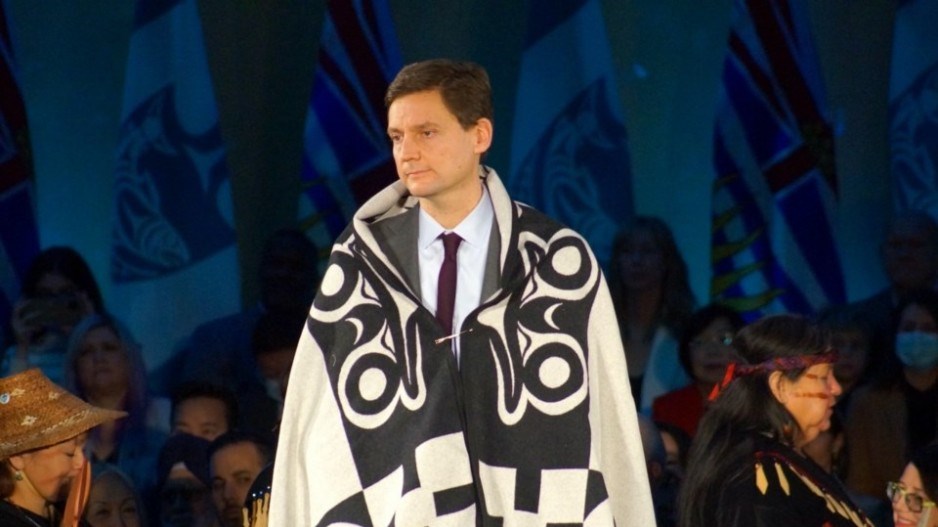When Amber Hockin announced she was leaving her job as deputy chief of staff to the premier last month, she made it sound to her colleagues like she was choosing to resign.
“I have decided that it is time to move on to another chapter in my life,” she wrote in an email sent to staff in the premier’s office. “One that is filled with grandkids and hobbies and other interests.”
But it turns out, she didn’t quite leave the way she’d led people to believe. Instead, Hockin got what amounted to a constructive dismissal from her position. By doing so, she collected $189,291 in severance to which she would not have been entitled if she’d simply retired or resigned.
The payout is just one part of an eye-wateringly rich set of severance payments funded by B.C. taxpayers during the transition from premiers John Horgan to David Eby.
The total? Almost $1.3 million to just five people.
The biggest recipient by far was Horgan’s deputy minister, Lori Wanamaker, who’d taken the job in 2020 after serving in the civil service since 1993. She was paid $591,089 in severance because Eby decided to replace her with Shannon Salter, the deputy attorney general he’d hired prior to becoming premier.
While the decision to fire Wanamaker was political, the government uses a non-partisan formula to determine severance for terminated employees. It includes several factors, such as length of service, salary and age (as a way of attempting to gauge future employability). Most times, if a person gets another job in a period of time after the severance, part of the amount is clawed back by the government.
Wanamaker had been making $331,447 a year as head of the public service. As for her future employability, after her departure the Eby cabinet named her to the board of BC Hydro, where directors make between $30,000 and $90,000 annually depending on their role and per-meeting subsidies.
The next highest payout was Don Zadravec, the deputy minister of communications. He was hired by the early John Horgan administration, having been a former communications official in the 1990s NDP government where Horgan himself had worked. The deputy minister of communications tends to be a political appointment for partisans, and this one was no different.
Eby's decision to replace Zadravec cost taxpayers $432,381. Zadravec had been getting paid $242,747 a year as a deputy minister. Eby replaced him with Marie Della Mattia, who had been Horgan’s top communications official in the 2017 election campaign that brought the NDP to power.
Then there’s Geoff Meggs, Horgan’s longtime chief of staff.
It’s unheard of for a new premier to retain the chief of staff of his predecessor, because the position by its very nature is a premier’s most confidential adviser, and doesn’t carry over between administrations.
But Meggs didn’t quit when Horgan quit. He waited to be fired. And so, he was able to take $339,784 in severance from the public purse. In his last year, he earned $211,621 in the role.
The last remaining severance (so far, anyway) was Horgan’s executive coordinator, Jarrett Hagglund, whose salary of $78,352 entitled him to a comparatively paltry severance of $75,366.
All governments undergo severance payments when they change hands.
In 2017, taxpayers paid out almost $12 million to 133 staffers when the BC Liberals were replaced by the new NDP government. In 2001, when the Liberals took power from the NDP, they paid out $9 million (adjusted for inflation) to more than 170 employees.
The difference in this case is that the governing party didn’t change, only the leaders. And yet it still cost taxpayers $1.3 million to fire five people.
There is an argument to be made that severance is a necessary part of the political game, because it provides a financial cushion to political staffers who, at any moment, could lose their jobs due to an election or change in power.
This is true. But it’s hard not to feel some money was wasted in this particular case. Wanamaker had a 29-year career in the civil service and was nearing retirement age anyway with a very lucrative government pension. She didn’t need a half-million-dollar golden handshake on her way out the door.
The same with Meggs, who was likely ready to leave at the age of 71, but hung around just long enough to get extra public cash to kickstart his retirement.
And then there is Hockin. She agreed to Eby’s initial job offer to remain his deputy chief of staff on Oct. 25. Then she found a way to get paid out anyway, and abruptly left on Nov. 18, the day of Eby’s swearing-in ceremony. I gather the new premier was not particularly impressed at the way she handled the situation.
Severance payments aren’t going anywhere any time soon. And they will undoubtedly be deployed again in the future if and when the NDP government is replaced by another party. Sometimes, they are a fair use of taxpayer funds. But in at least three of these particular cases, it’s hard to see what value the public got, if anything, by paying for these golden parachutes.
Rob Shaw has spent more than 14 years covering B.C. politics, now reporting for CHEK News and writing for Glacier Media. He is the co-author of the national bestselling book A Matter of Confidence, and a regular guest on CBC Radio.



